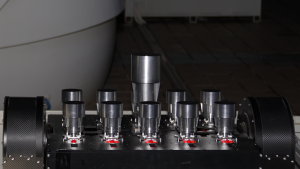Satellite ADCS operates in extreme space environments. It faces high vacuum, wide temperature cycles, space radiation, surface/deep charging from charged particles, Earth’s magnetic field variations, solar pressure, and LEO aerodynamic drag plus gravity gradient torque. Engineers use radiationhardened sensors/actuators, redundancy, local shielding, false star rejection, and current monitoring to ensure reliable operation throughout the full mission lifetime.
LEO Satellites: They experience strong atmospheric drag and gravity gradient torque. Therefore, ADCS prioritizes fast disturbance rejection. It achieves control bandwidth of 0.1–1 Hz and stabilizes torque up to 10⁻⁴ Nm.
GEO and MEO Satellites: These satellites mainly handle solar radiation pressure and magnetic torque. As a result, they demand strict pointing stability, typically under 0.1 degrees over 24 hours, to maintain geosynchronous lock.
Deep Space Missions: For probes like Voyager or New Horizons, ADCS operates in lowgravity environments with almost no external references. Consequently, it relies primarily on inertial sensors.

Thermal and Radiation Hardening
Satellites endure temperature swings from 150°C to +150°C. Therefore, ADCS components require thermal isolation and heaters to stay within operational limits. Designers measure radiation tolerance in kilorads (krad). Electronics typically exceed 100 krad tolerance to prevent singleevent upsets (SEU).
Power and Resource Management
ADCS power budget usually accounts for 5–20% of total satellite power. Systems include lowpower modes during eclipse periods. Additionally, smart power cycling extends battery life.
Regulatory and Standards Compliance for Satellite ADCS Design
Compliance with international standards ensures interoperability and safety. Key guidelines include:
ECSS Standards (European Cooperation for Space Standardization): They define reliability assessment and worstcase testing for ADCS.
NASA and ESA Requirements: These agencies mandate endtoend verification, including ground simulation and inorbit calibration.
Frequency Coordination: For communication satellites, ADCS provides precise beam pointing. This compliance follows ITU regulations and prevents interference with neighboring satellites.
Best Practices for Implementing Satellite ADCS Requirements
Modular Design: Designers use commercial offtheshelf components whenever possible to reduce costs. However, they customize them for missionspecific needs.
Simulation and Testing: Teams employ digital twins and hardwareintheloop (HIL) testing. Thus, they validate requirements under simulated orbital conditions.
Integration with Other Subsystems: Engineers ensure ADCS interfaces smoothly with propulsion, power, and payload systems. For example, it coordinates with the onboard computer for autonomous navigation.
Constellation Scalability: In megaconstellations like OneWeb, teams standardize ADCS requirements across the fleet. This approach simplifies manufacturing and operations.
Send us a message,we will answer your email shortly!